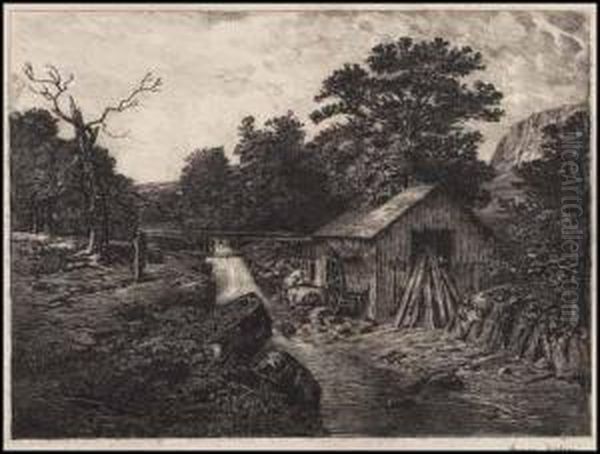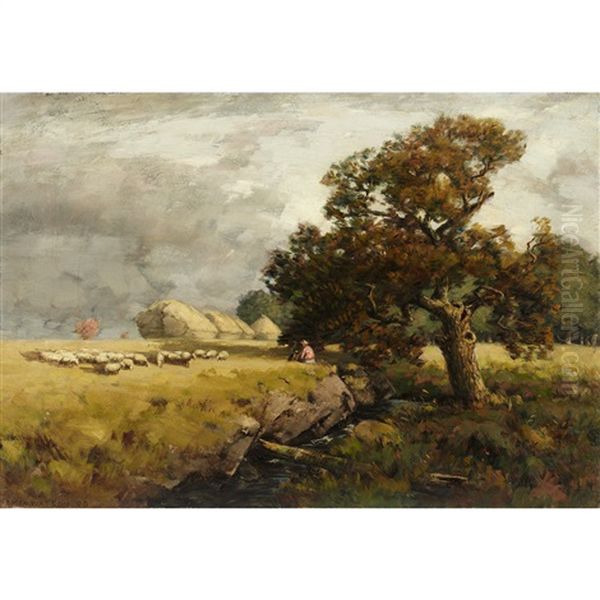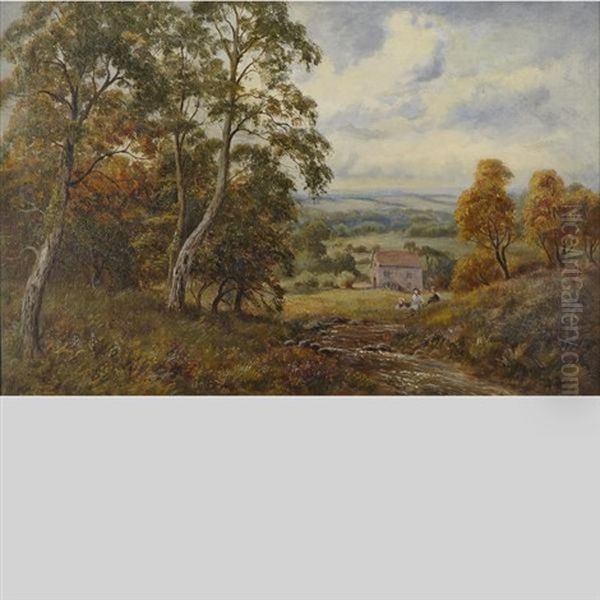
Homer Ransford Watson stands as a pivotal figure in the history of Canadian art, celebrated for his evocative and deeply personal depictions of the Canadian landscape. Born on January 14, 1855, in Doon, Ontario (now part of Kitchener), Watson's life and art became intrinsically linked with the natural beauty and pioneering spirit of his homeland. He passed away on May 30, 1936, leaving behind a legacy as one of Canada's first and most important landscape painters to forge a distinctly Canadian vision, moving away from purely European artistic conventions.
Early Life and Formative Influences
Homer Watson was the second son of Ransford Watson and Susan Mohr Watson. His early years in the village of Doon, nestled along the Grand River, provided him with an intimate connection to the rural Ontario landscape that would become the primary subject of his art. His father, who operated a woollen mill, unfortunately, passed away in 1861 when Homer was just six years old. This early loss plunged the family into financial hardship.
The young Watson was compelled to leave school and, alongside his older brother Jude, find work in a local brickyard to support the family. Tragedy struck again in 1867 when Jude died from an industrial accident. These profound losses at a young age are believed to have deepened Watson's sensitivity to the natural world, perhaps as a source of solace and contemplation, and also sparked an interest in the spiritual and the supernatural that would subtly permeate some of his later works.
Despite the lack of formal schooling, Watson was an avid reader and possessed a keen intellectual curiosity. His father's library, though modest, offered him glimpses into a wider world, including art. It was here, through books and reproductions, that his artistic inclinations began to take root.
A Self-Taught Artist's Journey

Homer Watson's artistic training was largely autodidactic. He demonstrated a passion for drawing from a young age. Around the age of eleven, he began experimenting with watercolors, and by fifteen, he had taught himself the rudiments of oil painting. His primary method of learning was through meticulous observation and the imitation of artworks he encountered in books and periodicals. This dedicated self-study laid the foundation for his technical skills.
In 1874, at the age of nineteen, Watson made a significant move to Toronto. This relocation marked the formal beginning of his artistic career. In Toronto, he sought out opportunities to view art and connect with other artists. He spent some time working at the Notman-Fraser photographic studio, an experience that may have honed his eye for composition and tonal values, common among artists of that era who sometimes used photographs as aides-mémoires.
During his time in Toronto, Watson also immersed himself in studying the collection of paintings at the Toronto Normal School (now part of Toronto Metropolitan University). He was particularly drawn to the works of British Romantic painters, whose dramatic and emotional interpretations of landscape resonated with his own burgeoning artistic sensibilities. The influence of artists like John Constable, with his fresh, direct approach to nature, can be discerned in Watson's developing style.
Travels and Expanding Horizons
A pivotal trip for Watson occurred in 1876 when he traveled to New York State. There, he encountered the works of the Hudson River School painters. Artists such as Thomas Cole, Asher B. Durand, Frederic Edwin Church, and Albert Bierstadt, who celebrated the grandeur and wildness of the American landscape, undoubtedly made an impression on the young Canadian. Their emphasis on detailed realism combined with a romantic, almost reverential, view of nature aligned with Watson's own inclinations. He was particularly impressed by the work of George Inness, an American landscape painter whose style evolved from the detailed realism of the Hudson River School towards a more atmospheric and spiritual quality influenced by the Barbizon School.
Later, between 1887 and 1890, Watson traveled to England and Scotland. This period was crucial for his artistic development. He had the opportunity to see firsthand the works of British masters like Constable and J.M.W. Turner, whose handling of light and atmosphere was revolutionary. More significantly, he spent time with contemporary British artists, including Sir George Clausen, a prominent figure associated with British Impressionism and rural naturalism.

During his time abroad, Watson also absorbed the influence of the French Barbizon School. Painters like Jean-Baptiste-Camille Corot, Jean-François Millet, and Théodore Rousseau, who focused on realistic depictions of rural life and landscape with an emphasis on mood and atmosphere, deeply affected his artistic vision. Their practice of painting en plein air (outdoors) to capture the immediate effects of light and weather, and their sympathetic portrayal of peasant life, found echoes in Watson's subsequent work, albeit translated to a Canadian context.
Artistic Style and Evolution
Homer Watson's artistic style was not static; it evolved throughout his long career, reflecting his experiences, influences, and deepening understanding of his subject matter.
Early Style: Watson's early works, emerging in the late 1870s and early 1880s, are characterized by a detailed, somewhat tighter realism, likely influenced by his self-study, photographic work, and the Hudson River School. He paid close attention to the specific features of the Ontario landscape, rendering trees, water, and pioneer structures with considerable accuracy. A romantic sensibility often imbued these scenes, as seen in works like Old Mill and Stream. He often began with meticulous sketches and drawings from nature, which then formed the basis for his oil paintings.
Mid-Career Development: As Watson matured, particularly after his experiences in Europe, his style began to loosen. While still grounded in realism, he became more interested in capturing the overall mood and atmosphere of a scene rather than an exhaustive inventory of details. His brushwork became more visible and expressive, often employing a technique of applying thick paint (impasto) to create texture and convey the solidity of forms. The influence of the Barbizon School is evident in his richer, often darker, tonal harmonies and his focus on the elemental forces of nature. Works from this period, such as Log-cutting in the Woods, emphasize the inherent power and spirit of the Canadian wilderness. There's a growing sense of the sublime, where nature is portrayed as both beautiful and formidable.

Late Style: In the later stages of his career, from the early 20th century onwards, Watson's style continued to evolve. He often used a brighter palette and became increasingly adept at capturing the ephemeral effects of light and weather. His compositions sometimes became simpler and more monumental, focusing on broad masses and dramatic skies. There's a heightened emotional and spiritual quality in many of his later landscapes. Paintings like Near the Close of a Stormy Day and Mountain River showcase his mastery of atmosphere and his ability to convey the profound, almost mystical, character of the Canadian scene. He often simplified compositions, bringing the horizon line closer to create a greater sense of depth and immediacy.
Technical Characteristics: Throughout his career, Watson was known for his robust handling of paint. His use of impasto was a signature technique, giving his canvases a tangible, sculptural quality. This is particularly evident in works like The Flood Gate, where the texture of the paint contributes to the sense of turbulent water and solid structures. While primarily an oil painter, Watson also explored other media, including watercolor and etching, further demonstrating his versatility.
Key Themes in Watson's Art
Several recurring themes define Homer Watson's body of work, reflecting his deep connection to his environment and his philosophical outlook.
The Canadian Landscape: First and foremost, Watson was a painter of Canada, specifically the rural landscapes of Southern Ontario. He depicted the farmlands, forests, rivers, and pioneer settlements with an authenticity and affection that was groundbreaking for its time. He captured the unique character of the region – its changing seasons, its rugged beauty, and the interplay of human activity with the natural world.
Pioneer Life and Heritage: Many of Watson's paintings document the era of pioneer settlement in Ontario. Works like The Pioneer Mill (also known as The Old Mill) are not just picturesque scenes but also records of a way of life that was rapidly changing. These paintings often evoke a sense of nostalgia and respect for the resilience and industry of the early settlers. They speak to a Canadian identity rooted in the land and the efforts to tame and cultivate it.
The Power and Spirit of Nature: Watson's landscapes often convey a profound respect for the power and majesty of nature. He was drawn to dramatic weather conditions – stormy skies, the aftermath of a downpour, the quiet of a winter's day. His trees are often gnarled and ancient, imbued with a sense of character and endurance. There is an underlying spiritual quality in his work, a suggestion that nature possesses an intrinsic spirit or life force. This was likely influenced by his personal interest in spiritualism and the transcendentalist ideas prevalent in the 19th century.
Environmentalism and Conservation: Long before environmentalism became a mainstream concern, Watson demonstrated a deep love for and a desire to protect the natural world. His paintings themselves are a testament to the beauty he found in unspoiled landscapes. More actively, he was a co-founder of the Grand River Park Company, which aimed to preserve natural areas along the Grand River, including Cressman Woods, which he helped save from logging. This initiative led to the creation of what is now the Homer Watson Park. His art and actions underscored an early Canadian consciousness about the importance of preserving natural heritage.
Representative Masterpieces
Several paintings stand out as iconic examples of Homer Watson's oeuvre, encapsulating his style and thematic concerns.
The Pioneer Mill (c. 1878-1879, also known as Down in the Laurentides when first exhibited, later titled The Pioneer Mill by the Marquis of Lorne): This is arguably Watson's breakthrough work. Exhibited at the first exhibition of the Royal Canadian Academy of Arts in 1880, it was purchased by the then Governor General, the Marquis of Lorne, for Queen Victoria. The painting depicts an old grist mill, a common feature of the pioneer landscape, nestled by a stream. It combines detailed observation with a romantic atmosphere, capturing the rustic charm and historical significance of such structures. Its acquisition by the Queen brought Watson significant recognition both in Canada and internationally.
The Flood Gate (c. 1900-1901): This powerful painting showcases Watson's mature style. It depicts a torrent of water rushing through a sluice gate, with a dramatic, cloudy sky above. The use of thick impasto to render the churning water and the solid, weathered wood of the gate is masterful. The painting conveys the raw energy of nature and the robust engineering of human intervention. It is a dynamic and emotionally charged work, reflecting Watson's fascination with the elemental forces of water and weather.
Nut Gatherers in the Forest (1900): This work shows a different facet of Watson's engagement with the landscape, focusing on human figures within a woodland setting. The figures are somewhat diminutive compared to the towering trees, emphasizing the scale and majesty of the forest. The play of light filtering through the canopy creates a dappled, atmospheric effect, characteristic of Barbizon influences.
Near the Close of a Stormy Day (1907): This painting is a superb example of Watson's late style, demonstrating his ability to capture dramatic atmospheric effects. The scene is suffused with the lingering light after a storm, with dark, brooding clouds giving way to a luminous sky. The landscape is rendered with broad, confident brushstrokes, emphasizing mood and emotion over precise detail. It speaks to the sublime power of nature and its capacity for both turmoil and tranquility.
Leadership in Canadian Art Institutions
Homer Watson was not only a prolific painter but also a significant figure in the organization and promotion of Canadian art. He played a key role in establishing institutions that would support and elevate Canadian artists.
Royal Canadian Academy of Arts (RCA): Watson was a charter member of the RCA, founded in 1880 under the patronage of the Marquis of Lorne and Princess Louise. His early success with The Pioneer Mill at the RCA's inaugural exhibition highlighted the potential for Canadian artists to gain recognition. He remained actively involved with the Academy throughout his career, and from 1918 to 1922, he served as its President. His leadership during this period helped to solidify the RCA's role as a national institution for the arts.
Canadian Art Club (CAC): In 1907, Watson, along with fellow artist Edmund Morris, co-founded the Canadian Art Club in Toronto. The club's primary aim was to provide a venue for Canadian artists to exhibit works of a high standard, offering an alternative to the established art societies and promoting a distinctly Canadian school of painting. They sought to elevate the status of Canadian art and reduce the reliance on imported European works. Watson served as the CAC's first president from 1907 to 1911. The club, though relatively short-lived (disbanding in 1915), played an important role in fostering a sense of national identity in Canadian art and included prominent members like Horatio Walker and Franklin Brownell.
Relationships with Contemporaries
Watson's career spanned a period of significant development in Canadian art, and he interacted with many other artists of his time.
Collaborations and Shared Ideals: He shared a studio in Toronto for a time with Frederick Arthur Verner, another notable Canadian painter known for his depictions of Indigenous peoples and prairie landscapes. His collaboration with Edmund Morris in founding the Canadian Art Club demonstrates a shared vision for advancing Canadian art. He was part of a generation of artists, including Lucius O'Brien (the first president of the RCA) and John Arthur Fraser (of Notman-Fraser), who were working to establish a professional artistic community in Canada.
Artistic Differences: While Watson was a pioneer in his own right, he was not always in sympathy with the artistic directions taken by younger generations. He reportedly expressed dissatisfaction with the brightly colored, more stylized, and design-heavy approach of painters like Tom Thomson and the artists who would form the Group of Seven (such as Lawren Harris, A.Y. Jackson, J.E.H. MacDonald, Arthur Lismer, Franklin Carmichael, F.H. Varley, and A.J. Casson). Watson's aesthetic remained rooted in the 19th-century landscape traditions of the Barbizon and Hudson River Schools, emphasizing tonal harmonies and a more naturalistic, if romanticized, representation. The Group of Seven, emerging in the years Watson was president of the RCA, sought a more radical, modernist interpretation of the Canadian landscape, often focusing on the rugged North. This difference in artistic philosophy highlights the evolving nature of Canadian art during Watson's lifetime.
International Recognition and Exhibitions
Homer Watson's work gained considerable recognition beyond Canada's borders. His participation in international exhibitions helped to raise the profile of Canadian art on the world stage.
His painting The Pioneer Mill being acquired by Queen Victoria was a significant early endorsement. He exhibited at the Colonial and Indian Exhibition in London in 1886. He also participated in major American expositions, including the World’s Columbian Exposition in Chicago in 1893, where he was awarded a gold medal for his work, a significant honor. He also showed at the Pan-American Exposition in Buffalo in 1901. In 1894, he received an award for the best landscape painting at the Montreal Art Association Spring Exhibition.
These international accolades were important not only for Watson's personal career but also for demonstrating that Canadian artists could compete and achieve recognition at the highest levels. His success helped to build confidence within the Canadian art community.
Later Years and Enduring Legacy
In his later years, Homer Watson continued to paint, though his output may have lessened due to declining health. He remained in Doon, his lifelong home, which became a place of pilgrimage for younger artists and admirers. His home and studio are now the Homer Watson House & Gallery, a public art gallery and museum dedicated to preserving his legacy and promoting contemporary art.
Homer Ransford Watson's contributions to Canadian art are manifold. He was one of the first Canadian-born artists to achieve international fame for his depictions of his native land. He championed a vision of Canadian landscape painting that was authentic and deeply felt, moving beyond mere imitation of European models. His work celebrated the beauty of rural Ontario, the legacy of its pioneers, and the enduring power of nature.
His commitment to art extended to his active role in founding and leading key Canadian art institutions. He was a mentor and an inspiration to many, even if his artistic style differed from later modernist movements. In recognition of his profound impact on Canadian culture, Homer Watson was designated a National Historic Person of Canada. His paintings are held in major collections across Canada, including the National Gallery of Canada, the Art Gallery of Ontario, and numerous regional galleries.
Conclusion
Homer Ransford Watson's art provides a vital link to Canada's past, capturing a period of transition and growth in the nation's history. He was a painter of immense skill and sensitivity, whose love for the Canadian landscape shines through in every canvas. His dedication to forging a distinctly Canadian artistic voice, his leadership in the art community, and his early advocacy for environmental preservation secure his place as a foundational figure in Canadian art history. His work continues to resonate with audiences today, offering timeless reflections on the beauty, power, and spirit of the Canadian land.